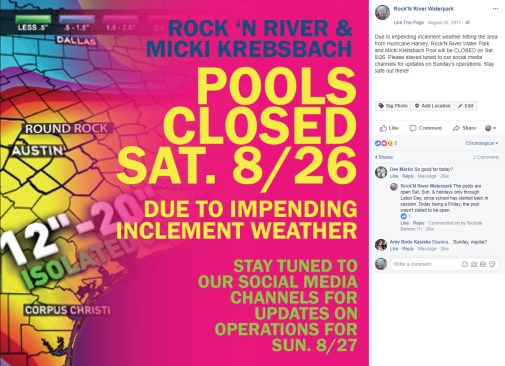A few years back in late spring, as we prepared our pools for a Memorial Day Opening, a family showed up at our gates in full swim regalia, ready to jump into our pool — which had not yet opened for the season!
Not only was I tasked with breaking the news to this excited family that we weren’t open, but I wondered what had brought them to us on that day in the first place. As an operator, I knew that our seasonal pools have historically opened in late May, so it seemed odd to even think that we would be open on a weekday in mid-April. They had to be new to the area or just passing through to think we would be open so early, right? It likely took some effort for Mom and her three young kiddos to put on their swimsuits, get buckled into the car, and show up at our gates. My inquiring mind wanted to know what they were doing here!
In approaching the family, I let them know that the pools actually wouldn’t open for a few more weeks. As we spoke, they explained, “Your website said you were open.” Knowing full well that we had scoured our website up and down with a team of reviewers a month before, I knew this was not the case. So I sent the customers on their way, with our apologies and a printed schedule.
But then …. it happened again. Another family arrived geared up and ready for a swim during hours when we clearly were closed. This time, I heard the same story about the website saying we were open, so I asked the customer to show me the site. I quickly realized the source of the misinformation: A third-party site, which we did not control, had listed us as open! It was a hot Texas day, and both these mamas referred to the first thing that popped up on their phones, which was a Google listing that gave incorrect hours.
At this point, I realized I needed to ensure that we had more control over our facilities’ online presence.
Naively, I assumed that our website would be the first place a customer would reference, since it obviously would contain the most accurate, up-to-date information. That would be a “go straight to the source” kind of move. I failed to realize that some folks assume the top listing in a web search comes from the source, even when it isn’t an official facility website.
Since then, we have incorporated these practices to take control of our representation on the internet.
Internet Power Move No. 1: Evaluate Your Online Presence.
Perform an online search for your facility and see what comes up. What you see is what your customers see!
Evaluate the websites that are listed from multiple search engines — and do so from both a desktop and mobile device, because sometimes they differ. What sites and links do you find? Is the information correct?
Who owns the sites? If the sites listing your facility are outside of your organization, contact them and ensure that they have updated links that push customers directly to your webpage instead of having specific hours listed on their site.
Where else are customers searching for information about your facility? Try Google Listings/Maps, Facebook, Yelp and Trip Advisor for destination facilities. Is their information correct?
Internet Power Move No. 2: Claim your Social Media and Search Engine Listings.
The landscape of online listing services is ever-changing. Many sites that contain pool listings, such as Google, Facebook and Yelp, contain avenues for an operator to claim existing pages for their facilities. All have slightly different criteria that involve a verification process, and the details can be found on each respective site.
A few examples: If you have an unclaimed Google listing, the site will show information that is submitted via crowdsourcing. That could work for a year-round facility whose hours don’t really change, but many pool operations run seasonally with different hours, depending on the time of year. In this case, the crowdsourcing model becomes much less reliable. By claiming your listing, you can take control of the situation and enable yourself to post real-time facility hours and dates with the most recent and accurate information.
Most recently, I had an experience claiming a Facebook listing. We had a city pool that was listed on Facebook with 692 likes. We went through the necessary steps, which included an over-the-phone code verification, and we also provided a utility bill showing the facility’s address.
Once we claimed our page with Facebook, we had a ready-made audience — folks who have already visited and enjoyed our pool. By claiming the listing, we created a direct stream to communicate with those 692 guests on a social media platform that they already use.
Internet Power Move No. 3: Engage your ready-made audience.
Now that you’ve claimed your social media and search engine listings, most sites allow you to post to your audience.
Consider what would excite your target audience about your facility. We found success in hosting a giveaway. After we posted a promotion for a Fourth of July party, we offered an incentive for guests to share our post on their social media feeds. They were entered for a chance to win a free rental cabana during the event.
Not only did this engage our waterpark’s 5,000 existing fans — as they shared the post, they spread the excitement and buzz to a much larger audience, i.e. people who also wanted a chance to enjoy a personal cabana space during the party.

This also served as a helpful tool to spread the word about an unexpected pool closure that occurred because of inclement weather. When Hurricane Harvey hit Texas, the surrounding storms in central Texas necessitated that we close our pools. The facility’s Facebook pages effectively supplemented our existing protocols for getting the word out.
